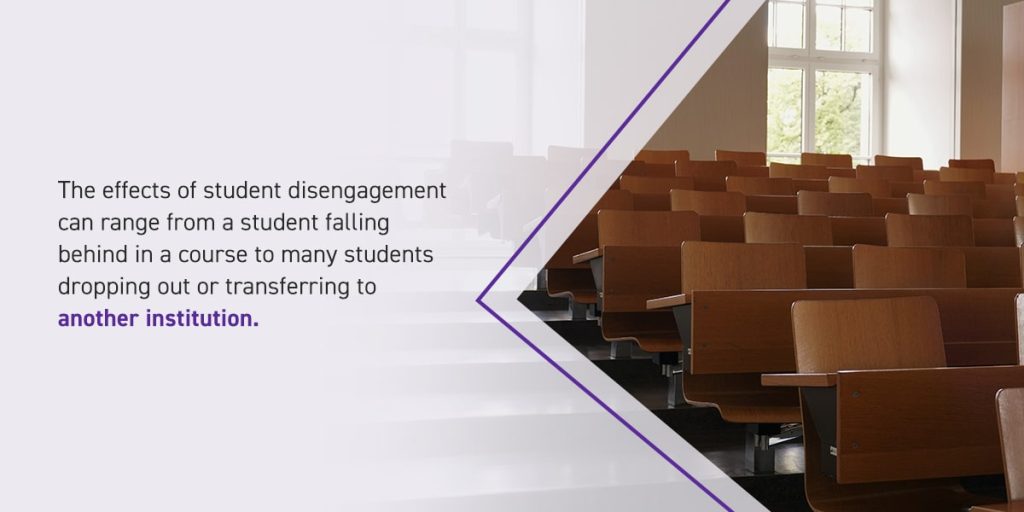Student engagement details the degree of interest, curiosity, passion, optimism, and attention your students show in the classroom. High levels of engagement are a good indicator of student success and can help predict graduation rates, retention rates, and other data that benefit your institution.
Student engagement takes the form of many positive outcomes, and the factors that influence it can change with each institution. Understanding what can affect engagement can help you develop strategies that connect your students with their studies and help ensure their success.
What Are the Benefits of Student Engagement?
Student engagement plays an essential role in higher education. Student engagement promotes a caring environment that fosters learning and supports students. Engagement inspires students to practice and acquire the skills they need to succeed in their fields. It helps students develop strong communication skills, enhance negotiation skills, and encourage a greater sense of responsibility and ownership.
Student engagement also encourages strong relationships with peers, instructors, and faculty members. The increased conversation helps build student skillsets and enhance their personalities as they engage with new perspectives and work to drive change together.
Strong student engagement can lead to increased performance, and your institution can experience higher retention rates that help you save money and dedicate resources toward student resources like writing centers, scheduling centers, and internship offices.
Factors Affecting Student Engagement in Higher Education
There are many reasons for a lack of student engagement. On-campus experiences and off-campus factors can either hinder or boost engagement. Student engagement can skyrocket with the proper support and resources, but without them, students can become detached or find it challenging to complete their best work. Factors that influence engagement include:
- Family support: Parents, guardians, and other familial figures can impede or boost student engagement. A robust support system can give students a place to turn if they need assistance or help set goals and ambitions. However, a lack of family support or unrealistic expectations can become demanding for students and affect their ability to perform their best.
- Campus culture: A positive environment supporting growth, communication, and a sense of belonging can encourage students to interact with new perspectives and engage with people from different backgrounds. This can create a foundation for intelligent discussion and help form new ideas.
- Lack of resources: Campus resources and assistance programs support student success. Writing centers, internship offices, mentors, and scheduling centers provide students with assistance to complete assignments, register for classes, and otherwise continue toward graduation. Insufficient resources or a lack of resources can impede student success by not providing students who have fallen behind with the help they need.
- Financial stability: Many students face economic challenges while in college or university. Students may miss classes or neglect school assignments to work a part-time job. Additionally, financial burdens can become a stressor that causes an inability to focus, sleep, or be productive.
- Poor self-esteem: High self-esteem can be a motivator for academic achievement, while low self-esteem can result in lower grades, poor relationships, and a lack of perseverance.
- Staff professional development: Instructors who deeply understand their fields can deliver new and exciting information to students. Additionally, educators who enjoy their jobs can teach enthusiastically and create engaging activities and assignments for students to complete, rather than teachers with only lectures.
- Class size: Large classes can feel impersonal to some students. They may feel discouraged from asking for course help, assignment extensions, or additional resources when they cannot form a personal connection with the instructor.
- Curriculum: Students are more likely to be engaged in classes if the course materials are interesting and relevant. Instructors can use real-world examples and shape courses to fit the current climate so students can see how their knowledge applies to the world.

How to Identify a Lack of Student Engagement
Identifying a lack of engagement is just as important as recognizing high levels of engagement. The effects of student disengagement can range from a student falling behind in a course to many students dropping out or transferring to another institution. Disengagement can also impact institutional initiatives and impede goal progress.
Signs of student disengagement include:
- Neglecting to attend classes
- Avoiding coursework
- Showing significant changes in behavior
- Having a lack of interest in studies and materials
- Exhibiting behavioral issues in the classroom
- Showing an unwillingness to participate in discussions
- Arriving late to classes
- Giving up easily on tasks
- Tuning out or appearing bored
Strategies to Increase Student Engagement in Higher Education
Increasing student engagement can be simple. There are many small steps your institution can take to promote student engagement and help them reach success.
One of the first things you can do to increase engagement is to ask your students what they need to succeed. Collecting student feedback can also help increase engagement. For example, course evaluations and surveys give insight into the student experience, enabling you to understand what students would like to see in the classroom. You can discover effective teaching methods and what students enjoy about the curriculum.
Leveraging technology can also increase student engagement. You can use social media to connect with students off-campus and create interesting conversations. You can send out polls, create profiles for clubs, and send reminders for campus events and activities. Additionally, you can create more enriching classes by using online discussion boards, presentations, and slideshows.
One of the most important steps you can take is to ensure instructors are using class time efficiently. Career readiness is essential, and 80% of students believe this is the most critical aspect of student success. Ensuring your students can apply their knowledge to real-world experience and their industries can deeply connect them with their studies and help boost classroom engagement.

Improve student outcomes with Watermark
Watermark has spent more than 20 years crafting innovative solutions for higher education institutions to foster student success and empower students. Our experience has enabled us to develop software solutions for colleges and universities to create holistic academic experiences that boost student engagement.
Watermark Student Success & Engagement offers advanced, intuitive reporting so you can create customizable reports to access the information you need quickly and easily. You can create guided student pathways to ensure every student has the support they need to succeed and receive alerts anytime a student falls off track. You can easily assign tasks, track attendance, and schedule student appointments. Students can seamlessly connect with their peers and build a sense of belonging that boosts engagement and positively contributes to the campus culture.
Request a demo of Student Success & Engagement and deliver your student the support they need from the beginning of their academic journey.

















































































































































































































































































































































































































